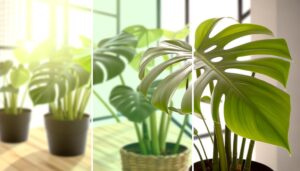How Often to Water Monstera Deliciosa
Watering Monstera deliciosa requires a combination of understanding its natural habitat and monitoring local conditions. In summer, check soil moisture every 2-3 days, maintaining the soil evenly moist but not waterlogged.
In winter, reduce watering to every 3-4 weeks due to decreased metabolic rates. Factors like ambient humidity (optimal 60-80%), plant maturity, and soil drainage greatly impact watering frequency.
Use a moisture meter for precision, and make sure the top 2 inches of soil are dry before watering. Employing proper watering techniques can prevent common issues such as root rot and leaf browning.
For detailed guidelines and advanced care strategies, continue further.
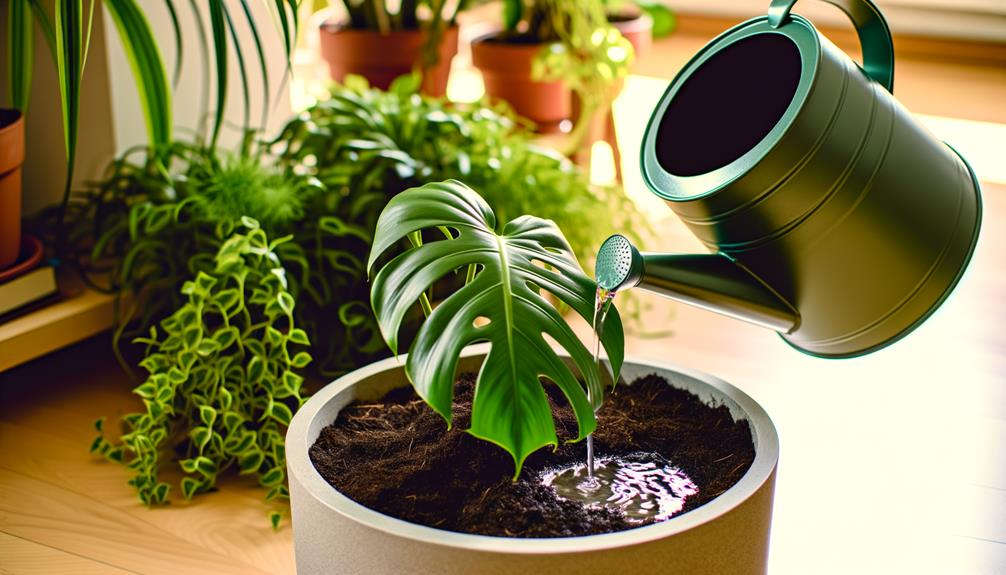
Key Takeaways
- Water Monstera Deliciosa when the top 2 inches of soil are dry.
- Adjust watering frequency based on seasonal changes; every 2-3 days in summer, every 3-4 weeks in winter.
- Larger, mature plants require more frequent watering compared to juvenile plants.
- Use well-draining soil to prevent waterlogging and root rot.
- Maintain indoor humidity levels between 60-80% to support healthy growth.
Understanding Monstera's Water Needs
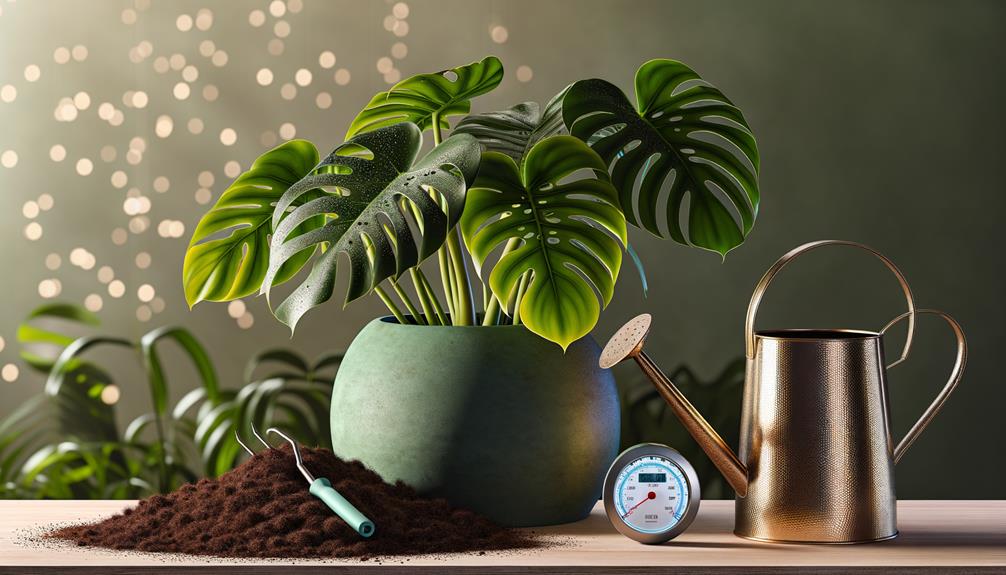
Understanding Monstera deliciosa's water needs requires a detailed analysis of its natural habitat, physiological characteristics, and seasonal variations in water uptake.
Native to the tropical rainforests of Central and South America, Monstera thrives in high humidity and receives consistent rainfall. It has developed a robust root system capable of storing water, reflecting its adaptation to sporadic dry spells.
Physiologically, its large, fenestrated leaves increase transpiration, necessitating a balanced hydration strategy. Seasonal variations also play a critical role; during the growing season (spring and summer), Monstera demands more frequent watering, while in the dormant phase (fall and winter), its water requirements decrease.
Understanding these factors ensures ideal hydration, promoting healthy growth and preventing root rot or dehydration.
Signs Your Monstera Needs Water
One of the primary indicators that your Monstera deliciosa needs water is the noticeable drooping of its leaves, which results from decreased turgor pressure within the plant cells. Turgor pressure, driven by water within the vacuoles, maintains cell rigidity; a deficit causes cellular flaccidity and subsequent leaf droop.
Additionally, the soil's surface may appear dry and compacted, signaling insufficient moisture. Leaf edges may also exhibit browning or curling, indicative of water stress. A lack of sheen on the foliage, usually a sign of ideal hydration, can further confirm the need for watering.
Observing these physiological symptoms and soil conditions provides crucial insight into the hydration status of Monstera deliciosa, ensuring timely and efficient watering practices.
Factors Affecting Water Frequency
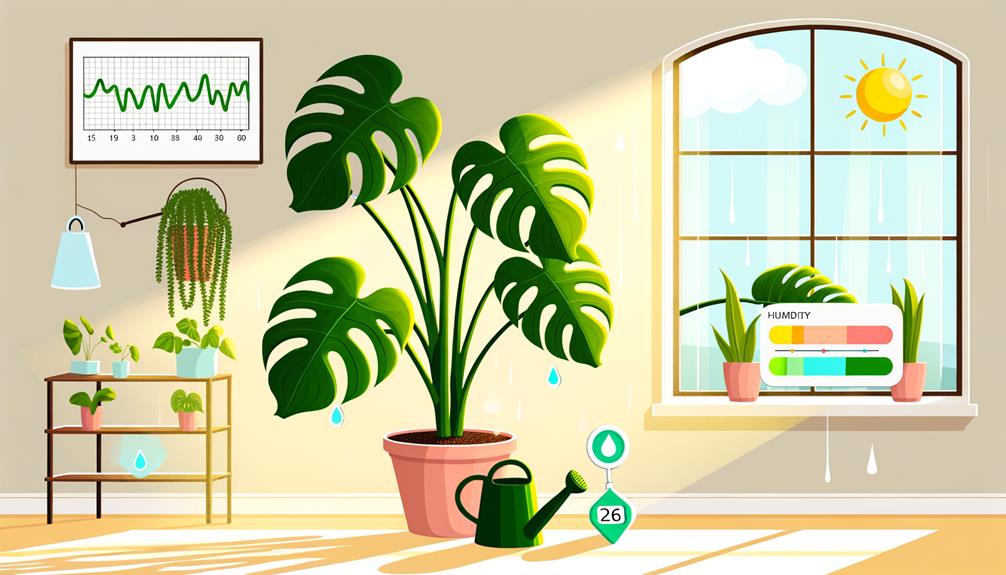
Watering frequency for Monstera Deliciosa is influenced by several important factors including:
- Climate and humidity levels
- Plant size and age
- Soil type and drainage
Variations in these parameters can greatly alter the plant's water requirements, requiring adjustments in watering schedules. Understanding these factors is essential for maintaining ideal hydration and preventing both under- and over-watering.
Climate and Humidity Levels
The frequency of watering Monstera Deliciosa is heavily influenced by the prevailing climate and ambient humidity levels, which directly affect the plant's rate of transpiration and water uptake.
In arid environments with low humidity, the plant's leaves transpire more rapidly, requiring more frequent watering to prevent desiccation.
Conversely, in humid climates, the high moisture content in the air reduces transpiration rates, allowing for less frequent watering.
Additionally, temperature fluctuations play a significant role; higher temperatures accelerate water evaporation from both the soil and the plant, thereby increasing water requirements.
Best humidity levels for Monstera Deliciosa range between 60-80%, ensuring balanced water absorption and transpiration.
Monitoring these environmental parameters is essential for maintaining the plant's health and preventing water stress.
Plant Size and Age
In addition to climate and humidity, the size and age of Monstera Deliciosa significantly impact its watering frequency. Larger and more mature plants generally require different hydration schedules compared to their younger and smaller counterparts.
Mature Monsteras possess an extensive root system and larger leaves, which increase their transpiration rate and water uptake. Consequently, they necessitate more frequent watering to maintain turgor pressure and overall physiological functions.
Conversely, juvenile plants, with their relatively smaller root networks and less foliage, retain moisture for longer periods and hence require less frequent watering.
Monitoring soil moisture levels, rather than adhering to a strict schedule, is essential for adjusting watering practices to suit the specific growth stage and size of the Monstera Deliciosa.
Soil Type and Drainage
Ideal soil type and drainage are critical determinants of the watering frequency for Monstera Deliciosa, as they directly influence the plant's ability to retain and release moisture. A well-draining soil mix, typically composed of peat, perlite, and orchid bark, ensures the best moisture balance. Proper drainage prevents waterlogging, which can lead to root rot, a common issue for Monstera Deliciosa. The soil's composition affects its porosity and thereby its aeration and water retention properties.
| Soil Component | Function | Proportion |
|---|---|---|
| Peat | Retains moisture | 40% |
| Perlite | Enhances drainage | 30% |
| Orchid Bark | Provides aeration | 30% |
Understanding these elements helps in tailoring a watering schedule that meets the plant's specific needs.
Seasonal Watering Guidelines
Seasonal variations greatly influence the watering regimen for Monstera Deliciosa, necessitating adjustments to maintain best plant health.
During the summer months, increased temperatures and light intensity typically require more frequent watering to counteract higher rates of evaporation and transpiration.
Conversely, in winter, reduced light and cooler temperatures result in slower growth rates, thereby decreasing the plant's overall water requirements.
Summer Watering Frequency
During the summer months, Monstera Deliciosa typically requires more frequent watering due to increased temperatures and higher rates of evapotranspiration. This heightened need arises from the plant's accelerated metabolic processes and faster soil moisture depletion.
For best hydration, consider the following guidelines:
- Soil Moisture Monitoring: Check soil moisture levels every 2-3 days. The top inch should remain consistently damp but not waterlogged.
- Water Quantity: Adjust the volume of water to make sure it penetrates the root zone, typically until excess water drains from the pot's bottom.
- Environmental Conditions: Take into account ambient temperature and humidity levels; higher conditions necessitate more frequent watering.
Winter Watering Needs
As temperatures drop during the winter months, Monstera Deliciosa's watering needs decrease considerably due to its reduced metabolic rate and slower soil moisture evaporation. It is crucial to adjust the watering frequency accordingly to prevent root rot.
Typically, watering every 3-4 weeks suffices, depending on the ambient indoor humidity and temperature. Using a moisture meter can provide accurate measurements, ensuring the soil remains slightly moist but not waterlogged. Reducing the water volume helps maintain ideal soil conditions. Be sure the potting medium is well-draining to prevent water accumulation.
Observing leaf conditions—such as yellowing or wilting—can offer additional insights into the plant's hydration needs. Proper winter watering practices are essential for Monstera Deliciosa's health and longevity.
How to Check Soil Moisture
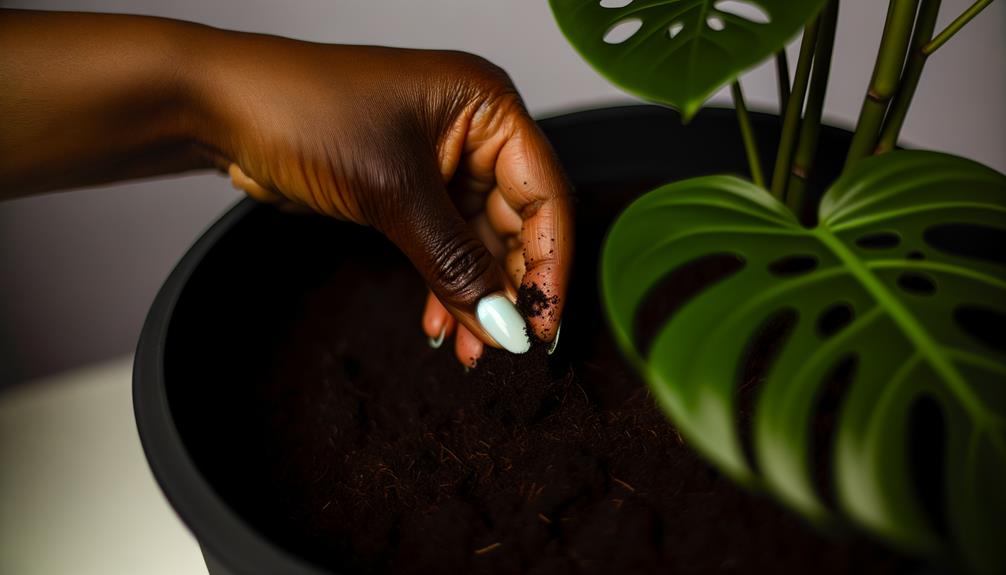
To accurately assess the soil moisture of Monstera deliciosa, one should employ a combination of tactile and instrumental methods to achieve ideal hydration levels.
First, insert your finger approximately two inches into the soil. If it feels dry, watering may be necessary.
Next, utilize a soil moisture meter, which provides a quantitative measure of soil moisture content, ensuring precision.
Finally, observe the soil color and texture—dark, crumbly soil typically indicates adequate moisture, while light, powdery soil suggests dryness.
- Finger Test: Insert finger to check for dryness at two inches depth.
- Soil Moisture Meter: Use to obtain quantitative moisture readings.
- Visual and Tactile Inspection: Examine soil color and texture for moisture clues.
These methods collectively guarantee ideal hydration for Monstera deliciosa.
Best Watering Techniques
Understanding the best methods for watering Monstera deliciosa involves not only evaluating soil moisture accurately but also implementing scientifically-backed watering techniques to guarantee plant health and growth. Best watering practices require attention to the plant's natural habitat and physiological needs. Use a moisture gauge for precise soil moisture readings, making sure water is applied when the top 2 inches of soil are dry. Incorporate the bottom-irrigation method by placing the pot in a water-filled tray, allowing capillary action to hydrate roots evenly. Additionally, consider the watering frequency adjustments based on seasonal changes and indoor conditions.
| Technique | Description |
|---|---|
| Moisture Gauge | Measures soil moisture accurately |
| Bottom-Irrigation | Ensures even hydration via capillary action |
| Seasonal Modification | Modifies watering frequency based on environmental cues |
Consistent monitoring and scientific methods enhance Monstera care.
Avoiding Common Watering Mistakes
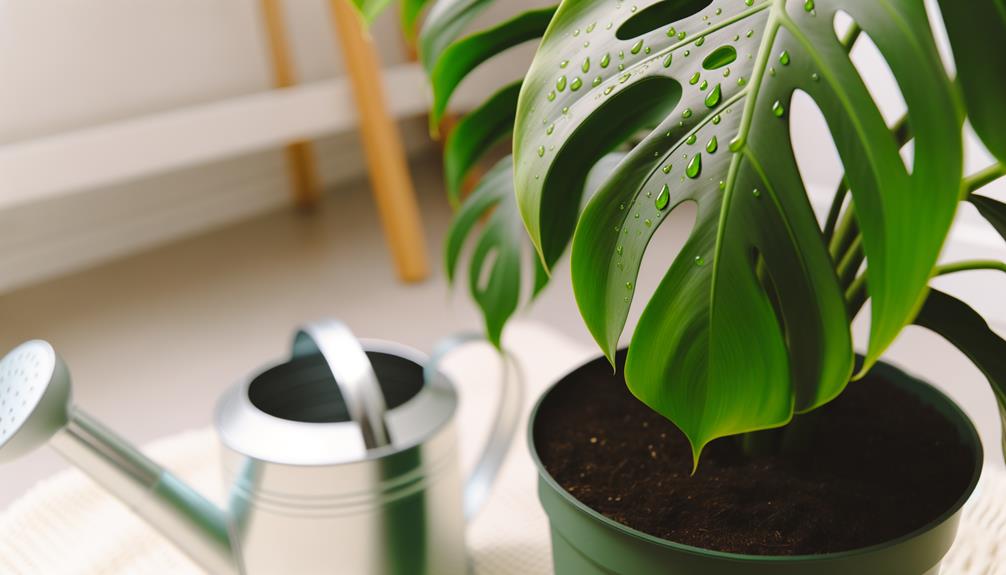
A critical aspect of Monstera deliciosa care involves identifying and rectifying prevalent watering errors to prevent root rot and promote ideal growth. Overwatering is the primary culprit leading to root rot, characterized by yellowing leaves and a musty odor.
Conversely, underwatering can cause leaf curling and browning edges. To avoid these issues, consider the following steps:
- Check soil moisture: Insert a finger 1-2 inches into the soil; water only if dry.
- Use pots with drainage holes: This prevents water accumulation at the root zone.
- Adjust watering frequency seasonally: Reduce watering during winter when the plant's growth rate slows.
Water Quality for Monstera
In addition to proper watering techniques, the quality of water used for Monstera deliciosa is essential to ensuring ideal plant health and growth. Tap water often contains chlorine, chloramine, and other chemicals that can be detrimental to Monstera. Using filtered or distilled water can mitigate these risks. Hard water, high in calcium and magnesium, can lead to mineral buildup in the soil, negatively impacting root function.
| Water Source | Quality Considerations |
|---|---|
| Tap Water | May contain chlorine and chloramine |
| Filtered Water | Reduced chemical contaminants |
| Distilled Water | Free of minerals and impurities |
| Rainwater | Naturally soft and devoid of harmful chemicals |
Monitoring water pH, ideally between 5.5 and 7, is also essential for nutrient uptake and overall plant well-being.
Using Humidity to Your Advantage
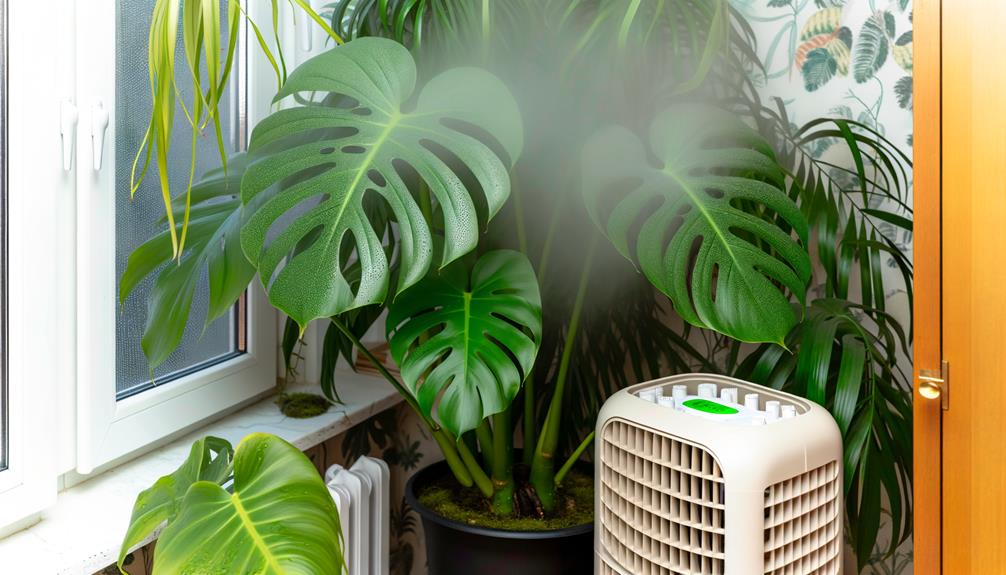
Optimizing ambient moisture levels is vital for the physiological processes and overall health of Monstera deliciosa. High humidity facilitates stomatal function and transpiration, important for nutrient uptake and photosynthesis.
To leverage humidity effectively, consider the following strategies:
- Humidifiers: Employing a humidifier guarantees a consistent humidity level between 60-80%, ideal for Monstera deliciosa.
- Misting: Regular misting can temporarily increase local humidity around the plant, although it should not replace thorough humidity management.
- Water Trays: Placing a tray filled with water and pebbles beneath the plant can create a micro-environment of increased humidity through evaporation.
These methods can greatly enhance the plant's vitality and growth, ensuring the best physiological function and aesthetic appeal.
Adjusting for Pot Size and Soil
Understanding the impact of pot size and soil composition is essential to achieving the best water retention and root health for Monstera deliciosa.
Larger pots hold more soil, which can retain moisture for extended periods, reducing the frequency of watering. Conversely, smaller pots dry out quicker, necessitating more frequent watering.
The soil mix is equally important; a well-draining mix, typically containing peat, perlite, and bark, prevents waterlogging and root rot. Incorporating aerating components like pumice or charcoal enhances oxygen flow to roots.
Monitoring moisture levels is crucial, using tools such as moisture meters or the finger test to avoid overwatering. Proper adjustments tailored to pot size and soil type ensure optimal hydration and robust growth for the Monstera deliciosa.
Conclusion
To conclude, the precise hydration of Monstera deliciosa hinges on understanding its water needs, recognizing signs of thirst, and considering environmental factors.
Seasonal variations and soil moisture checks are essential, while avoiding common watering pitfalls safeguards plant health.
The quality of water, coupled with ideal humidity levels, enhances growth. Adjusting care based on pot size and soil composition is vital.
Mastering these elements results in a thriving Monstera deliciosa, embodying botanical vitality and lushness.



